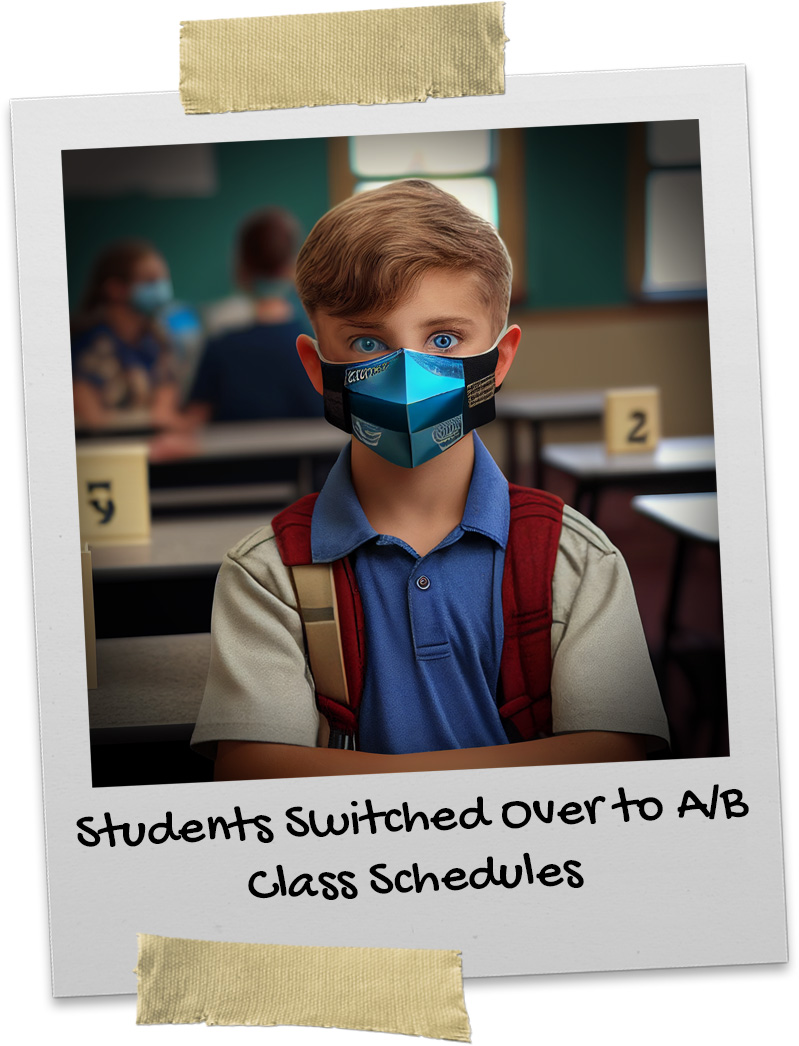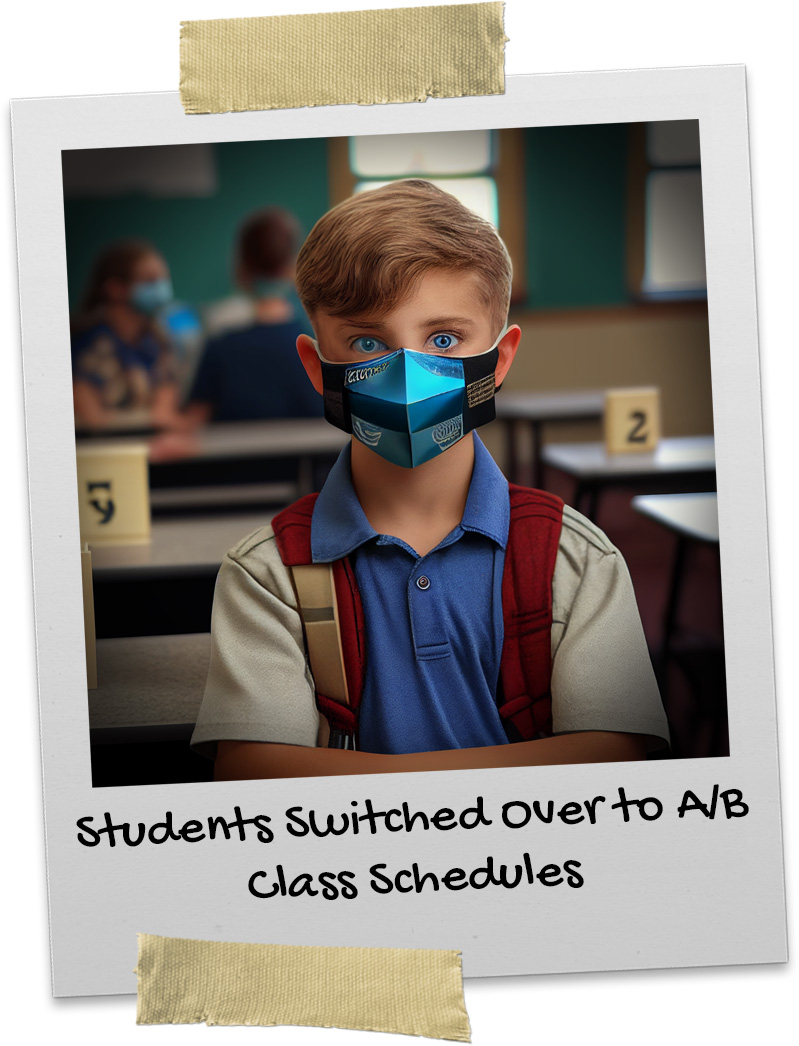Students Switched Over to A/B Class Schedules


After the pandemic shut the 2019-2020 school year down, school leaders and parents were faced with a challenging decision about whether to continue with distance learning or attempt a more complex approach known as a "hybrid" model starting in the Fall of 2020.
This approach involved a combination of in-person classes, online instruction, and a lengthy set of regulations designed to limit the spread of COVID-19. The hybrid model aimed to meet students' academic, emotional, and social needs by bringing them back together with teachers and peers, which was seen as both important and urgent after months of isolation and online lessons.
However, reopening schools under strict capacity limits and social distancing requirements meant that many students had to attend classes on rotating schedules: A/B Scheduling.
Monday and Tuesday, Group A would attend in-person classes while Group B participated in virtual learning. On Thursday and Friday, the groups would switch, with Group A participating in virtual learning and Group B attending in-person classes. On Wednesday, everybody stayed home so they could clean the school. By staggering the schedules and reducing the number of students in the building at any given time, schools were able to reduce the risk of transmission and create a safer learning environment.
This raised concerns for teachers, who had to manage split classrooms, and parents who had to manage their children's weird schedules, as they still only attended school twice a week, and may have siblings with different schedules in the same household. In essence, it was a challenging logistical issue that caused significant concern for everyone who was involved.
A lot of people just wanted the schools re-opened completely, but reluctantly accepted hybrid as the next best option to get students back in the classroom. The results of the experiment went about how you could imagine.
In general, the experience of being in the classroom was great. Less students, less distraction, and more of the teachers undivided attention for each student. It mimicked more of a private school environment, with smaller class size and devoted attention from the teacher. It made you think about what the ideal class size and the ideal structure would be. Half of a classroom full of kids worked very well.
Conversely, the experience of learnings on their home days felt like not really going to school at all. The teacher had very little time to help the students, apart from a short overview at the beginning of the day. It was up to the students and their parents to figure out what work was assigned and to plow through the mounds of stapled workbook packets and iPads with bundles of learning apps.
The software loaded on the iPads ranged from barely usable to sometimes horrendously bad. Terrible user interfaces and difficult tools to take screenshots and submit work were the standard. Specifically, two popular learning platforms, Seesaw and IXL, notoriously created more problems than the actual curriculum. Teachers would be frustrated because half of their job was technical service support. Students were so frustrated with the technology that they would just shut down. All in all, it was not the ideal learning environment.
Understandably, some parents just developed the “To hell with this!” attitude and let their kids off the hook when it came time to turn in daily assignments. In return, teachers and administrators stopped marking work late and many districts refused to give students failing grades.
Most kids got the best learning environment for the two days in the classroom, and then got the feeling of being left behind on the two days distance learning from home. It was a weird way to try balance the classroom and a poor way to sustain learning momentum with students throughout the week.
But what about Wednesdays? That is the part that is most interesting. Why did the the school need to have Wednesdays off? Was it that the classrooms got so epically destroyed on Monday and Tuesday that it was forced to take a full day to put it back together for the other group of students to use on Thursday and Friday? It shouldn’t have, with only half the school being there you would think half the mess.
Was it that the school was being overrun with germs? Students and teachers were required to wear a face mask the entire day. Coronavirus spread mainly through airborne particles and droplets. There shouldn’t have been that many particles in the air if everyone was masked up. A proper spraying down of each desktop or workspace should have been an adequate precaution if one was worried about the virus living on surfaces for extended periods of time. Wiping down each desktop shouldn’t take all day, should it?
Why did the schools push for that middle day to be an everyone-stays-home day? One answer was the teachers’ unions. There was a study that found that school districts with lengthier collective bargaining agreements were less likely to start fall 2020 with full in-person instruction, spend more time in distance learning, and were less likely to ever have in-person classes at all in the fall semester.
Teachers’ unions are some one of the most powerful organizations in the country. While the decision to shut schools down in the spring of 2020 was largely decided at each state level, by the fall of 2020, most of the 13,000 school districts were left on their own to make their reopening plans. At the local level, teachers’ unions are even stronger. Many of the smaller school districts waited for larger neighboring districts to put a policy in place, and then just let the policy cascade to them. The mighty teachers’ union was responsible for setting the guidelines for re-opening.
Teachers’ unions utilize master negotiators to define their collective bargaining agreements. Every bone of contention is looked at as an opportunity to claw something back in their next contract. For instance, the teachers’ union might say that they don’t want the schools open at all—it’s much too dangerous for their teachers to be teaching under the circumstances. But they may be willing to compromise, perhaps, with a hybrid arrangement, if it meant maybe a 5% salary raise, guaranteed smaller class sizes, or better health care benefits during the next contract negotiations. Typically, there is never a concession without a return.
It was reasonable to anticipate that the teachers' unions would impede decisions to reopen schools, just as we would anticipate their efforts to push for more education funding in the state, smaller class sizes, and better sick leave for teachers. The union's duty is to safeguard and speak for the interests of teachers, and their effectiveness is measured by how well they fulfill this responsibility.
At the end of the day, the decision to shut down schools and then reopen them with hybrid learning plans boiled down to two questions. People decided how to judge that decision based on their responses.
How much risk do you think in-person teaching caused the students and teachers?
How much damage did distance learning cause the children in development, both educationally and socially?
If you thought the risk of the virus was higher than the damage done by distance learning, you most likely didn’t have any hard feelings towards the teachers’ union. If you thought that the risk of the pandemic was minuscule because children weren’t really affected by the virus like adults, but that the damage that children suffered from a year of distance learning may be irreparable, then at least a portion of your displeasure could be directed at the teachers’ union.



